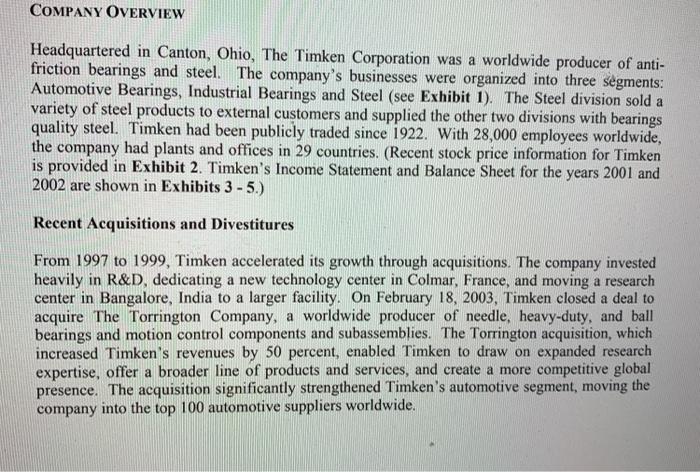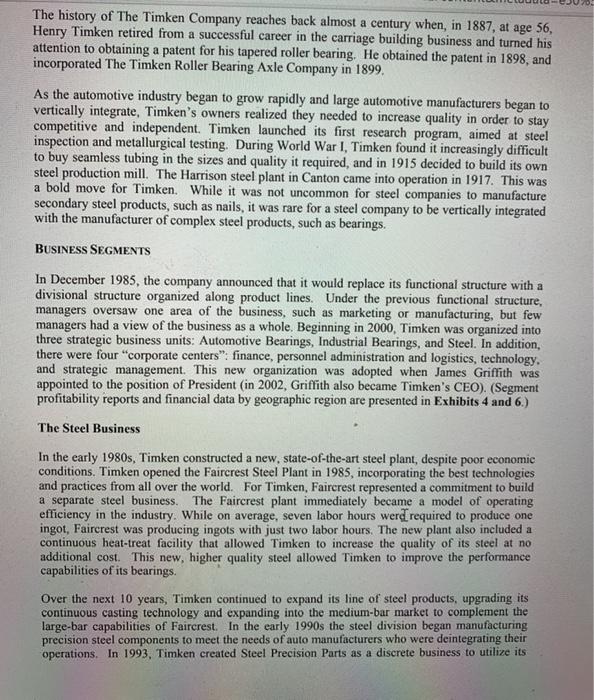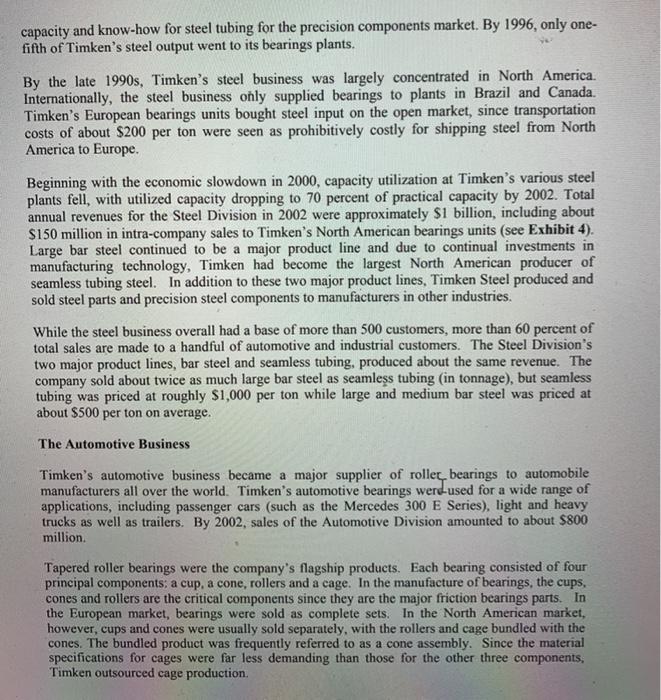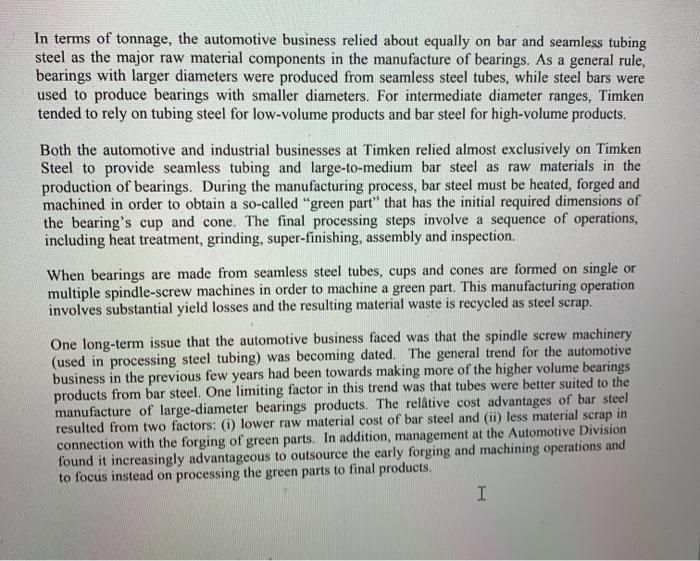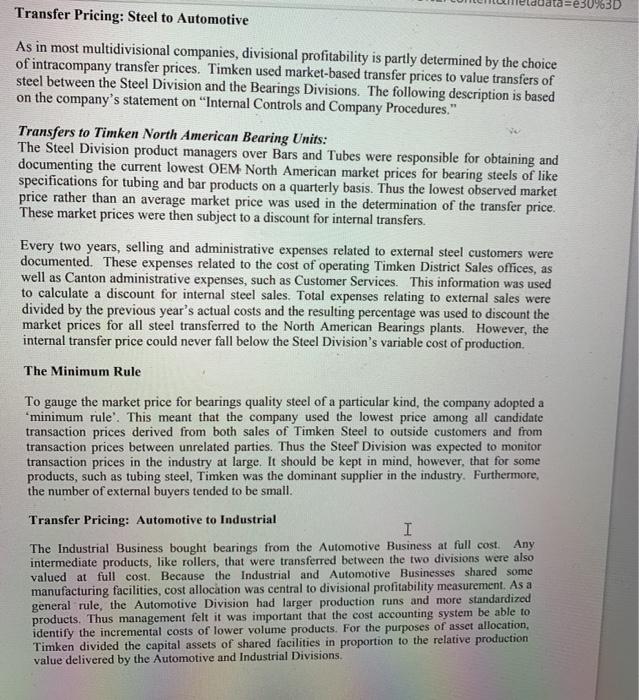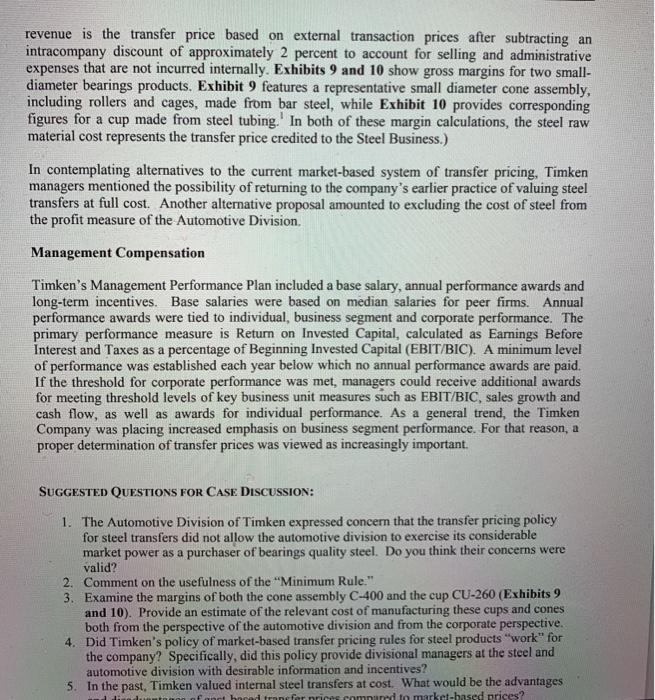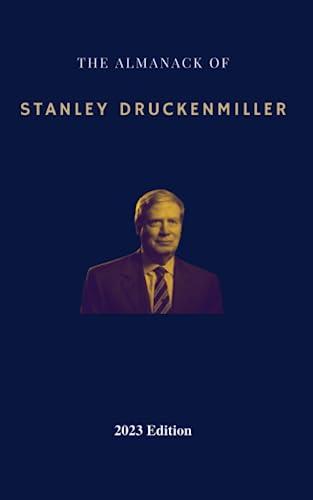COMPANY OVERVIEW Headquartered in Canton, Ohio, The Timken Corporation was a worldwide producer of anti- friction bearings and steel. The company's businesses were organized into three segments: Automotive Bearings, Industrial Bearings and Steel (see Exhibit 1). The Steel division sold a variety of steel products to external customers and supplied the other two divisions with bearings quality steel. Timken had been publicly traded since 1922. With 28,000 employees worldwide, the company had plants and offices in 29 countries. (Recent stock price information for Timken is provided in Exhibit 2. Timken's Income Statement and Balance Sheet for the years 2001 and 2002 are shown in Exhibits 3 - 5.) Recent Acquisitions and Divestitures From 1997 to 1999, Timken accelerated its growth through acquisitions. The company invested heavily in R&D, dedicating a new technology center in Colmar, France, and moving a research center in Bangalore, India to a larger facility. On February 18, 2003, Timken closed a deal to acquire The Torrington Company, a worldwide producer of needle, heavy-duty, and ball bearings and motion control components and subassemblies. The Torrington acquisition, which increased Timken's revenues by 50 percent, enabled Timken to draw on expanded research expertise, offer a broader line of products and services, and create a more competitive global presence. The acquisition significantly strengthened Timken's automotive segment, moving the company into the top 100 automotive suppliers worldwide. The history of The Timken Company reaches back almost a century when, in 1887, at age 56, Henry Timken retired from a successful career in the carriage building business and turned his attention to obtaining a patent for his tapered roller bearing. He obtained the patent in 1898, and incorporated The Timken Roller Bearing Axle Company in 1899. As the automotive industry began to grow rapidly and large automotive manufacturers began to vertically integrate, Timken's owners realized they needed to increase quality in order to stay competitive and independent. Timken launched its first research program, aimed at steel inspection and metallurgical testing. During World War I, Timken found it increasingly difficult to buy seamless tubing in the sizes and quality it required, and in 1915 decided to build its own steel production mill. The Harrison steel plant in Canton came into operation in 1917. This was a bold move for Timken. While it was not uncommon for steel companies to manufacture secondary steel products, such as nails, it was rare for a steel company to be vertically integrated with the manufacturer of complex steel products, such as bearings. BUSINESS SEGMENTS In December 1985, the company announced that it would replace its functional structure with a divisional structure organized along product lines. Under the previous functional structure, managers oversaw one area of the business, such as marketing or manufacturing, but few managers had a view of the business as a whole. Beginning in 2000, Timken was organized into three strategic business units: Automotive Bearings, Industrial Bearings, and Steel. In addition, there were four "corporate centers", finance, personnel administration and logistics, technology, and strategic management. This new organization was adopted when James Griffith was appointed to the position of President in 2002, Griffith also became Timken's CEO). (Segment profitability reports and financial data by geographic region are presented in Exhibits 4 and 6.) The Steel Business In the early 1980s, Timken constructed a new, state-of-the-art steel plant, despite poor economic conditions. Timken opened the Faircrest Steel Plant in 1985, incorporating the best technologies and practices from all over the world. For Timken, Faircrest represented a commitment to build a separate steel business. The Faircrest plant immediately became a model of operating efficiency in the industry. While on average, seven labor hours were required to produce one ingot, Faircrest was producing ingots with just two labor hours. The new plant also included a continuous heat-treat facility that allowed Timken to increase the quality of its steel at no additional cost. This new, higher quality steel allowed Timken to improve the performance capabilities of its bearings. Over the next 10 years, Timken continued to expand its line of steel products, upgrading its continuous casting technology and expanding into the medium-bar market to complement the large-bar capabilities of Faircrest. In the early 1990s the steel division began manufacturing precision steel components to meet the needs of auto manufacturers who were deintegrating their operations. In 1993, Timken created Steel Precision Parts as a discrete business to utilize its capacity and know-how for steel tubing for the precision components market. By 1996, only one- fifth of Timken's steel output went to its bearings plants. By the late 1990s, Timken's steel business was largely concentrated in North America. Internationally, the steel business only supplied bearings to plants in Brazil and Canada. Timken's European bearings units bought steel input on the open market, since transportation costs of about $200 per ton were seen as prohibitively costly for shipping steel from North America to Europe Beginning with the economic slowdown in 2000, capacity utilization at Timken's various steel plants fell, with utilized capacity dropping to 70 percent of practical capacity by 2002. Total annual revenues for the Steel Division in 2002 were approximately $1 billion, including about $150 million in intra-company sales to Timken's North American bearings units (see Exhibit 4). Large bar steel continued to be a major product line and due to continual investments in manufacturing technology, Timken had become the largest North American producer of seamless tubing steel. In addition to these two major product lines, Timken Steel produced and sold steel parts and precision steel components to manufacturers in other industries. While the steel business overall had a base of more than 500 customers, more than 60 percent of total sales are made to a handful of automotive and industrial customers. The Steel Division's two major product lines, bar steel and seamless tubing, produced about the same revenue. The company sold about twice as much large bar steel as seamless tubing (in tonnage), but seamless tubing was priced at roughly $1,000 per ton while large and medium bar steel was priced at about $500 per ton on average. The Automotive Business Timken's automotive business became a major supplier of rolle bearings to automobile manufacturers all over the world. Timken's automotive bearings were used for a wide range of applications, including passenger cars (such as the Mercedes 300 E Series), light and heavy trucks as well as trailers. By 2002, sales of the Automotive Division amounted to about $800 million Tapered roller bearings were the company's flagship products. Each bearing consisted of four principal components: a cup, a cone, rollers and a cage. In the manufacture of bearings, the cups, cones and rollers are the critical components since they are the major friction bearings parts. In the European market, bearings were sold as complete sets. In the North American market, however, cups and cones were usually sold separately, with the rollers and cage bundled with the cones. The bundled product was frequently referred to as a cone assembly. Since the material specifications for cages were far less demanding than those for the other three components. Timken outsourced cage production In terms of tonnage, the automotive business relied about equally on bar and seamless tubing steel as the major raw material components in the manufacture of bearings. As a general rule, bearings with larger diameters were produced from seamless steel tubes, while steel bars were used to produce bearings with smaller diameters. For intermediate diameter ranges, Timken tended to rely on tubing steel for low-volume products and bar steel for high-volume products. Both the automotive and industrial businesses at Timken relied almost exclusively on Timken Steel to provide seamless tubing and large-to-medium bar steel as raw materials in the production of bearings. During the manufacturing process, bar steel must be heated, forged and machined in order to obtain a so-called "green part" that has the initial required dimensions of the bearing's cup and cone. The final processing steps involve a sequence of operations, including heat treatment, grinding, super-finishing, assembly and inspection, When bearings are made from seamless steel tubes, cups and cones are formed on single or multiple spindle-screw machines in order to machine a green part. This manufacturing operation involves substantial yield losses and the resulting material waste is recycled as steel scrap. One long-term issue that the automotive business faced was that the spindle screw machinery (used in processing steel tubing) was becoming dated. The general trend for the automotive business in the previous few years had been towards making more of the higher volume bearings products from bar steel. One limiting factor in this trend was that tubes were better suited to the manufacture of large-diameter bearings products. The relative cost advantages of bar steel resulted from two factors: (i) lower raw material cost of bar steel and (ii) less material scrap in connection with the forging of green parts. In addition, management at the Automotive Division found it increasingly advantageous to outsource the early forging and machining operations and to focus instead on processing the green parts to final products I =e30%5D Transfer Pricing: Steel to Automotive As in most multidivisional companies, divisional profitability is partly determined by the choice of intracompany transfer prices. Timken used market-based transfer prices to value transfers of steel between the Steel Division and the Bearings Divisions. The following description is based on the company's statement on Internal Controls and Company Procedures." Transfers to Timken North American Bearing Units: The Steel Division product managers over Bars and Tubes were responsible for obtaining and documenting the current lowest OEM North American market prices for bearing steels of like specifications for tubing and bar products on a quarterly basis. Thus the lowest observed market price rather than an average market price was used in the determination of the transfer price. These market prices were then subject to a discount for internal transfers. Every two years, selling and administrative expenses related to external steel customers were documented. These expenses related to the cost of operating Timken District Sales offices, as well as Canton administrative expenses, such as Customer Services. This information was used to calculate a discount for internal steel sales. Total expenses relating to external sales were divided by the previous year's actual costs and the resulting percentage was used to discount the market prices for all steel transferred to the North American Bearings plants. However, the internal transfer price could never fall below the Steel Division's variable cost of production The Minimum Rule To gauge the market price for bearings quality steel of a particular kind, the company adopted a "minimum rule'. This meant that the company used the lowest price among all candidate transaction prices derived from both sales of Timken Steel to outside customers and from transaction prices between unrelated parties. Thus the Steel Division was expected to monitor transaction prices in the industry at large. It should be kept in mind, however, that for some products, such as tubing steel, Timken was the dominant supplier in the industry. Furthermore, the number of external buyers tended to be small. Transfer Pricing: Automotive to Industrial I The Industrial Business bought bearings from the Automotive Business at full cost. Any intermediate products, like rollers, that were transferred between the two divisions were also valued at full cost. Because the Industrial and Automotive Businesses shared some manufacturing facilities, cost allocation was central to divisional profitability measurement. As a general rule, the Automotive Division had larger production runs and more standardized products. Thus management felt it was important that the cost accounting system be able to identify the incremental costs of lower volume products. For the purposes of asset allocation, Timken divided the capital assets of shared facilities in proportion to the relative production value delivered by the Automotive and Industrial Divisions. In December of 2003, the management teams at the automotive and steel businesses were principally in agreement that market price was the appropriate instrument for valuing internal steel transfers. At the same time, both management teams had reservations about details of the implementation of market-based transfer pricing as it stood. From the perspective of the Automotive Division, the main concern was the "thinness" of some of the markets. For seamless tubing steel, the Steel Division was the dominant supplier of bearings quality steel in North America. Conversely, the Automotive Division was also the largest buyer of such steel products on the North American Market. By comparison with steel tubing, the market for steel bar appeared to be more competitive, even though steel bar of bearings grade quality can also not be considered a commodity product. Roger Ellis, vice president of manufacturing in the Automotive Division, felt that in order for a market-based system to be credible, the Automotive Business would have to be allowed to solicit outside bids and follow through with steel purchases from external suppliers. He argued that his business segment was effectively under a directive to source all steel inputs internally and was therefore unable to use its considerable purchasing power to effectively negotiate competitive external prices and terms The Steel Division countered that it had several large clients and that the prices granted to these clients did reflect their purchasing power. Jim Holderbaum, vice president for business advancement and controller of the Steel Division, argued: There is nothing that the Automotive Division could do to usthe Steel Division that Caterpillar, General Motors and Boeing are not already doing to us." Both divisions expressed reservations about the minimum rule, though understandably for different reasons. The Steel Division believed that this rule might prevent proper gauging of current market prices. For instance, steel scrap the main raw material in steel production had been going up in price. Yet, some transactions in the market reflected long-term contracts based on earlier and lower input prices. As a consequence, the lowest transaction prices might result in transfer prices that were not reflective of current market conditions. The Automotive Division was concerned that the minimum rule might provide incentives for the Steel Division to forego marginally profitable sales to external clients because of the secondary impact of such transactions on internal transfer prices. The Steel Tivision dismissed such concerns, arguing that any attempt to game the system would fail because the "rejected" customers would then find another supplier and the lower transaction price would become part of the market price database anyway. Both divisions were keenly aware that Timken's competitiveness in the bearings business was highly sensitive to the valuation of steel transfers. The Steel Division expressed concem over recent, but still isolated, incidents in which a U.S. bearings plant sourced green parts from the European steel market. Both divisions wondered if the company was leaving money on the table when this happened. (Exhibits 7 and 8 show the gross margins for two representative steel products transferred from Steel to the Automotive Division. In both margin calculations, revenue is the transfer price based on external transaction prices after subtracting an intracompany discount of approximately 2 percent to account for selling and administrative expenses that are not incurred internally. Exhibits 9 and 10 show gross margins for two small- diameter bearings products. Exhibit 9 features a representative small diameter cone assembly, including rollers and cages, made from bar steel, while Exhibit 10 provides corresponding figures for a cup made from steel tubing. In both of these margin calculations, the steel raw material cost represents the transfer price credited to the Steel Business.) In contemplating alternatives to the current market-based system of transfer pricing, Timken managers mentioned the possibility of returning to the company's earlier practice of valuing steel transfers at full cost. Another alternative proposal amounted to excluding the cost of steel from the profit measure of the Automotive Division Management Compensation Timken's Management Performance Plan included a base salary, annual performance awards and long-term incentives. Base salaries were based on median salaries for peer firms. Annual performance awards were tied to individual, business segment and corporate performance. The primary performance measure is Return on Invested Capital, calculated as Earnings Before Interest and Taxes as a percentage of Beginning Invested Capital (EBIT/BIC). A minimum level of performance was established each year below which no annual performance awards are paid. If the threshold for corporate performance was met, managers could receive additional awards for meeting threshold levels of key business unit measures such as EBIT/BIC, sales growth and cash flow, as well as awards for individual performance. As a general trend, the Timken Company was placing increased emphasis on business segment performance. For that reason, a proper determination of transfer prices was viewed as increasingly important. SUGGESTED QUESTIONS FOR CASE DISCUSSION: 1. The Automotive Division of Timken expressed concern that the transfer pricing policy for steel transfers did not allow the automotive division to exercise its considerable market power as a purchaser of bearings quality steel. Do you think their concerns were valid? 2. Comment on the usefulness of the "Minimum Rule." 3. Examine the margins of both the cone assembly C-400 and the cup CU-260 (Exhibits 9 and 10). Provide an estimate of the relevant cost of manufacturing these cups and cones both from the perspective of the automotive division and from the corporate perspective. 4. Did Timken's policy of market-based transfer pricing rules for steel products "work" for the company? Specifically, did this policy provide divisional managers at the steel and automotive division with desirable information and incentives? 5. In the past, Timken valued internal steel transfers at cost. What would be the advantages haced transfer prices compared to market-based prices? 3. Performance Measures: Strategic performance measurement is complex in a decentralized firm as the transfer of goods between units affects each SBU's reported profitability. Timken is concerned that the current ROIC measure may be ineffective and not inducing the goal congruent behavior at the SBU level and non-financial measures seem to be non-existent a. Using your transfer pricing method from question 2. Recommend a set of performance measures should be used to positively motivate manager performance at Steel and Auto and that both protects SBU autonomy while achieving congruence at the corporate level 3.Performance Measures: Strategic performance measurement is complex in a decentralized firm as the transfer of goods between units affects each SBU's reported profitability. Timken is concerned that the current ROIC measure may be ineffective and not inducing the goal congruent behavior at the SBU level and non-financial measures seem to be non-existent. a. Using your transfer pricing method from question 2. Recommend a set of performance measures should be used to positively motivate manager performance at Steel and Auto and that both protects SBU autonomy while achieving congruence at the corporate level. Just the 3rd question I IS COMPANY OVERVIEW Headquartered in Canton, Ohio, The Timken Corporation was a worldwide producer of anti- friction bearings and steel. The company's businesses were organized into three segments: Automotive Bearings, Industrial Bearings and Steel (see Exhibit 1). The Steel division sold a variety of steel products to external customers and supplied the other two divisions with bearings quality steel. Timken had been publicly traded since 1922. With 28,000 employees worldwide, the company had plants and offices in 29 countries. (Recent stock price information for Timken is provided in Exhibit 2. Timken's Income Statement and Balance Sheet for the years 2001 and 2002 are shown in Exhibits 3 - 5.) Recent Acquisitions and Divestitures From 1997 to 1999, Timken accelerated its growth through acquisitions. The company invested heavily in R&D, dedicating a new technology center in Colmar, France, and moving a research center in Bangalore, India to a larger facility. On February 18, 2003, Timken closed a deal to acquire The Torrington Company, a worldwide producer of needle, heavy-duty, and ball bearings and motion control components and subassemblies. The Torrington acquisition, which increased Timken's revenues by 50 percent, enabled Timken to draw on expanded research expertise, offer a broader line of products and services, and create a more competitive global presence. The acquisition significantly strengthened Timken's automotive segment, moving the company into the top 100 automotive suppliers worldwide. The history of The Timken Company reaches back almost a century when, in 1887, at age 56, Henry Timken retired from a successful career in the carriage building business and turned his attention to obtaining a patent for his tapered roller bearing. He obtained the patent in 1898, and incorporated The Timken Roller Bearing Axle Company in 1899. As the automotive industry began to grow rapidly and large automotive manufacturers began to vertically integrate, Timken's owners realized they needed to increase quality in order to stay competitive and independent. Timken launched its first research program, aimed at steel inspection and metallurgical testing. During World War I, Timken found it increasingly difficult to buy seamless tubing in the sizes and quality it required, and in 1915 decided to build its own steel production mill. The Harrison steel plant in Canton came into operation in 1917. This was a bold move for Timken. While it was not uncommon for steel companies to manufacture secondary steel products, such as nails, it was rare for a steel company to be vertically integrated with the manufacturer of complex steel products, such as bearings. BUSINESS SEGMENTS In December 1985, the company announced that it would replace its functional structure with a divisional structure organized along product lines. Under the previous functional structure, managers oversaw one area of the business, such as marketing or manufacturing, but few managers had a view of the business as a whole. Beginning in 2000, Timken was organized into three strategic business units: Automotive Bearings, Industrial Bearings, and Steel. In addition, there were four "corporate centers", finance, personnel administration and logistics, technology, and strategic management. This new organization was adopted when James Griffith was appointed to the position of President in 2002, Griffith also became Timken's CEO). (Segment profitability reports and financial data by geographic region are presented in Exhibits 4 and 6.) The Steel Business In the early 1980s, Timken constructed a new, state-of-the-art steel plant, despite poor economic conditions. Timken opened the Faircrest Steel Plant in 1985, incorporating the best technologies and practices from all over the world. For Timken, Faircrest represented a commitment to build a separate steel business. The Faircrest plant immediately became a model of operating efficiency in the industry. While on average, seven labor hours were required to produce one ingot, Faircrest was producing ingots with just two labor hours. The new plant also included a continuous heat-treat facility that allowed Timken to increase the quality of its steel at no additional cost. This new, higher quality steel allowed Timken to improve the performance capabilities of its bearings. Over the next 10 years, Timken continued to expand its line of steel products, upgrading its continuous casting technology and expanding into the medium-bar market to complement the large-bar capabilities of Faircrest. In the early 1990s the steel division began manufacturing precision steel components to meet the needs of auto manufacturers who were deintegrating their operations. In 1993, Timken created Steel Precision Parts as a discrete business to utilize its capacity and know-how for steel tubing for the precision components market. By 1996, only one- fifth of Timken's steel output went to its bearings plants. By the late 1990s, Timken's steel business was largely concentrated in North America. Internationally, the steel business only supplied bearings to plants in Brazil and Canada. Timken's European bearings units bought steel input on the open market, since transportation costs of about $200 per ton were seen as prohibitively costly for shipping steel from North America to Europe Beginning with the economic slowdown in 2000, capacity utilization at Timken's various steel plants fell, with utilized capacity dropping to 70 percent of practical capacity by 2002. Total annual revenues for the Steel Division in 2002 were approximately $1 billion, including about $150 million in intra-company sales to Timken's North American bearings units (see Exhibit 4). Large bar steel continued to be a major product line and due to continual investments in manufacturing technology, Timken had become the largest North American producer of seamless tubing steel. In addition to these two major product lines, Timken Steel produced and sold steel parts and precision steel components to manufacturers in other industries. While the steel business overall had a base of more than 500 customers, more than 60 percent of total sales are made to a handful of automotive and industrial customers. The Steel Division's two major product lines, bar steel and seamless tubing, produced about the same revenue. The company sold about twice as much large bar steel as seamless tubing (in tonnage), but seamless tubing was priced at roughly $1,000 per ton while large and medium bar steel was priced at about $500 per ton on average. The Automotive Business Timken's automotive business became a major supplier of rolle bearings to automobile manufacturers all over the world. Timken's automotive bearings were used for a wide range of applications, including passenger cars (such as the Mercedes 300 E Series), light and heavy trucks as well as trailers. By 2002, sales of the Automotive Division amounted to about $800 million Tapered roller bearings were the company's flagship products. Each bearing consisted of four principal components: a cup, a cone, rollers and a cage. In the manufacture of bearings, the cups, cones and rollers are the critical components since they are the major friction bearings parts. In the European market, bearings were sold as complete sets. In the North American market, however, cups and cones were usually sold separately, with the rollers and cage bundled with the cones. The bundled product was frequently referred to as a cone assembly. Since the material specifications for cages were far less demanding than those for the other three components. Timken outsourced cage production In terms of tonnage, the automotive business relied about equally on bar and seamless tubing steel as the major raw material components in the manufacture of bearings. As a general rule, bearings with larger diameters were produced from seamless steel tubes, while steel bars were used to produce bearings with smaller diameters. For intermediate diameter ranges, Timken tended to rely on tubing steel for low-volume products and bar steel for high-volume products. Both the automotive and industrial businesses at Timken relied almost exclusively on Timken Steel to provide seamless tubing and large-to-medium bar steel as raw materials in the production of bearings. During the manufacturing process, bar steel must be heated, forged and machined in order to obtain a so-called "green part" that has the initial required dimensions of the bearing's cup and cone. The final processing steps involve a sequence of operations, including heat treatment, grinding, super-finishing, assembly and inspection, When bearings are made from seamless steel tubes, cups and cones are formed on single or multiple spindle-screw machines in order to machine a green part. This manufacturing operation involves substantial yield losses and the resulting material waste is recycled as steel scrap. One long-term issue that the automotive business faced was that the spindle screw machinery (used in processing steel tubing) was becoming dated. The general trend for the automotive business in the previous few years had been towards making more of the higher volume bearings products from bar steel. One limiting factor in this trend was that tubes were better suited to the manufacture of large-diameter bearings products. The relative cost advantages of bar steel resulted from two factors: (i) lower raw material cost of bar steel and (ii) less material scrap in connection with the forging of green parts. In addition, management at the Automotive Division found it increasingly advantageous to outsource the early forging and machining operations and to focus instead on processing the green parts to final products I =e30%5D Transfer Pricing: Steel to Automotive As in most multidivisional companies, divisional profitability is partly determined by the choice of intracompany transfer prices. Timken used market-based transfer prices to value transfers of steel between the Steel Division and the Bearings Divisions. The following description is based on the company's statement on Internal Controls and Company Procedures." Transfers to Timken North American Bearing Units: The Steel Division product managers over Bars and Tubes were responsible for obtaining and documenting the current lowest OEM North American market prices for bearing steels of like specifications for tubing and bar products on a quarterly basis. Thus the lowest observed market price rather than an average market price was used in the determination of the transfer price. These market prices were then subject to a discount for internal transfers. Every two years, selling and administrative expenses related to external steel customers were documented. These expenses related to the cost of operating Timken District Sales offices, as well as Canton administrative expenses, such as Customer Services. This information was used to calculate a discount for internal steel sales. Total expenses relating to external sales were divided by the previous year's actual costs and the resulting percentage was used to discount the market prices for all steel transferred to the North American Bearings plants. However, the internal transfer price could never fall below the Steel Division's variable cost of production The Minimum Rule To gauge the market price for bearings quality steel of a particular kind, the company adopted a "minimum rule'. This meant that the company used the lowest price among all candidate transaction prices derived from both sales of Timken Steel to outside customers and from transaction prices between unrelated parties. Thus the Steel Division was expected to monitor transaction prices in the industry at large. It should be kept in mind, however, that for some products, such as tubing steel, Timken was the dominant supplier in the industry. Furthermore, the number of external buyers tended to be small. Transfer Pricing: Automotive to Industrial I The Industrial Business bought bearings from the Automotive Business at full cost. Any intermediate products, like rollers, that were transferred between the two divisions were also valued at full cost. Because the Industrial and Automotive Businesses shared some manufacturing facilities, cost allocation was central to divisional profitability measurement. As a general rule, the Automotive Division had larger production runs and more standardized products. Thus management felt it was important that the cost accounting system be able to identify the incremental costs of lower volume products. For the purposes of asset allocation, Timken divided the capital assets of shared facilities in proportion to the relative production value delivered by the Automotive and Industrial Divisions. In December of 2003, the management teams at the automotive and steel businesses were principally in agreement that market price was the appropriate instrument for valuing internal steel transfers. At the same time, both management teams had reservations about details of the implementation of market-based transfer pricing as it stood. From the perspective of the Automotive Division, the main concern was the "thinness" of some of the markets. For seamless tubing steel, the Steel Division was the dominant supplier of bearings quality steel in North America. Conversely, the Automotive Division was also the largest buyer of such steel products on the North American Market. By comparison with steel tubing, the market for steel bar appeared to be more competitive, even though steel bar of bearings grade quality can also not be considered a commodity product. Roger Ellis, vice president of manufacturing in the Automotive Division, felt that in order for a market-based system to be credible, the Automotive Business would have to be allowed to solicit outside bids and follow through with steel purchases from external suppliers. He argued that his business segment was effectively under a directive to source all steel inputs internally and was therefore unable to use its considerable purchasing power to effectively negotiate competitive external prices and terms The Steel Division countered that it had several large clients and that the prices granted to these clients did reflect their purchasing power. Jim Holderbaum, vice president for business advancement and controller of the Steel Division, argued: There is nothing that the Automotive Division could do to usthe Steel Division that Caterpillar, General Motors and Boeing are not already doing to us." Both divisions expressed reservations about the minimum rule, though understandably for different reasons. The Steel Division believed that this rule might prevent proper gauging of current market prices. For instance, steel scrap the main raw material in steel production had been going up in price. Yet, some transactions in the market reflected long-term contracts based on earlier and lower input prices. As a consequence, the lowest transaction prices might result in transfer prices that were not reflective of current market conditions. The Automotive Division was concerned that the minimum rule might provide incentives for the Steel Division to forego marginally profitable sales to external clients because of the secondary impact of such transactions on internal transfer prices. The Steel Tivision dismissed such concerns, arguing that any attempt to game the system would fail because the "rejected" customers would then find another supplier and the lower transaction price would become part of the market price database anyway. Both divisions were keenly aware that Timken's competitiveness in the bearings business was highly sensitive to the valuation of steel transfers. The Steel Division expressed concem over recent, but still isolated, incidents in which a U.S. bearings plant sourced green parts from the European steel market. Both divisions wondered if the company was leaving money on the table when this happened. (Exhibits 7 and 8 show the gross margins for two representative steel products transferred from Steel to the Automotive Division. In both margin calculations, revenue is the transfer price based on external transaction prices after subtracting an intracompany discount of approximately 2 percent to account for selling and administrative expenses that are not incurred internally. Exhibits 9 and 10 show gross margins for two small- diameter bearings products. Exhibit 9 features a representative small diameter cone assembly, including rollers and cages, made from bar steel, while Exhibit 10 provides corresponding figures for a cup made from steel tubing. In both of these margin calculations, the steel raw material cost represents the transfer price credited to the Steel Business.) In contemplating alternatives to the current market-based system of transfer pricing, Timken managers mentioned the possibility of returning to the company's earlier practice of valuing steel transfers at full cost. Another alternative proposal amounted to excluding the cost of steel from the profit measure of the Automotive Division Management Compensation Timken's Management Performance Plan included a base salary, annual performance awards and long-term incentives. Base salaries were based on median salaries for peer firms. Annual performance awards were tied to individual, business segment and corporate performance. The primary performance measure is Return on Invested Capital, calculated as Earnings Before Interest and Taxes as a percentage of Beginning Invested Capital (EBIT/BIC). A minimum level of performance was established each year below which no annual performance awards are paid. If the threshold for corporate performance was met, managers could receive additional awards for meeting threshold levels of key business unit measures such as EBIT/BIC, sales growth and cash flow, as well as awards for individual performance. As a general trend, the Timken Company was placing increased emphasis on business segment performance. For that reason, a proper determination of transfer prices was viewed as increasingly important. SUGGESTED QUESTIONS FOR CASE DISCUSSION: 1. The Automotive Division of Timken expressed concern that the transfer pricing policy for steel transfers did not allow the automotive division to exercise its considerable market power as a purchaser of bearings quality steel. Do you think their concerns were valid? 2. Comment on the usefulness of the "Minimum Rule." 3. Examine the margins of both the cone assembly C-400 and the cup CU-260 (Exhibits 9 and 10). Provide an estimate of the relevant cost of manufacturing these cups and cones both from the perspective of the automotive division and from the corporate perspective. 4. Did Timken's policy of market-based transfer pricing rules for steel products "work" for the company? Specifically, did this policy provide divisional managers at the steel and automotive division with desirable information and incentives? 5. In the past, Timken valued internal steel transfers at cost. What would be the advantages haced transfer prices compared to market-based prices? 3. Performance Measures: Strategic performance measurement is complex in a decentralized firm as the transfer of goods between units affects each SBU's reported profitability. Timken is concerned that the current ROIC measure may be ineffective and not inducing the goal congruent behavior at the SBU level and non-financial measures seem to be non-existent a. Using your transfer pricing method from question 2. Recommend a set of performance measures should be used to positively motivate manager performance at Steel and Auto and that both protects SBU autonomy while achieving congruence at the corporate level 3.Performance Measures: Strategic performance measurement is complex in a decentralized firm as the transfer of goods between units affects each SBU's reported profitability. Timken is concerned that the current ROIC measure may be ineffective and not inducing the goal congruent behavior at the SBU level and non-financial measures seem to be non-existent. a. Using your transfer pricing method from question 2. Recommend a set of performance measures should be used to positively motivate manager performance at Steel and Auto and that both protects SBU autonomy while achieving congruence at the corporate level. Just the 3rd question I IS
